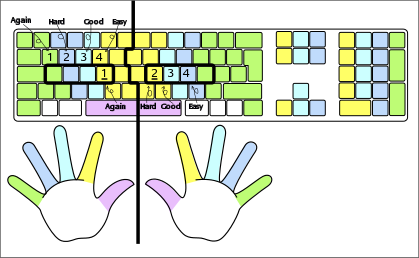
Use keys easy to use for user of the Dvorak simplified keyboard to answer a question.
The point is to remember the key positions, rather than the characters the keys usually produce.
There are three sets of keys to use. The first is with the four typing
fingers of the left hand in the row above the home row, going from
again
with the little finger,
through hard
with the ring finger, good
for the middle finger to
easy
for the index finger.
The second set is in the home position. Left index finger for again
and three fingers of the right hand: index finger for hard
, middle
finger for good
and ring finger for easy
.
The third set is similar to the first set, but in the bottom row,
here, too, going from little finger,
again
, to the index finger, easy
. (Some (German? international?)
keyboards have a small left shift key and an extra key for <
and
>
. That key is skipped.) (The idea for this set of keys came from
Peter Horwood, (Madman Pierre
), who has released
his own add-on which
does this remapping.)
These keys were selected so that they don’t clash with other functions like add card or edit card.
This is an Anki 2.0 plugin. I think i will update it to 2.1, but don’t know when i will get around to it. If you are impatient, you can of course do the update yourself. Please let me know which way you want your version published.
Configuration
The keys that are used are defined in a Python dictionary. Read the comments in the source file for details.
I tried to find good keys to use for QWERTY keyboards, but could not. My best idea was to use the four keys for the index fingers, in the home positions or reaching towards each other. These are there in a commented-out alternative version of the dictionary.